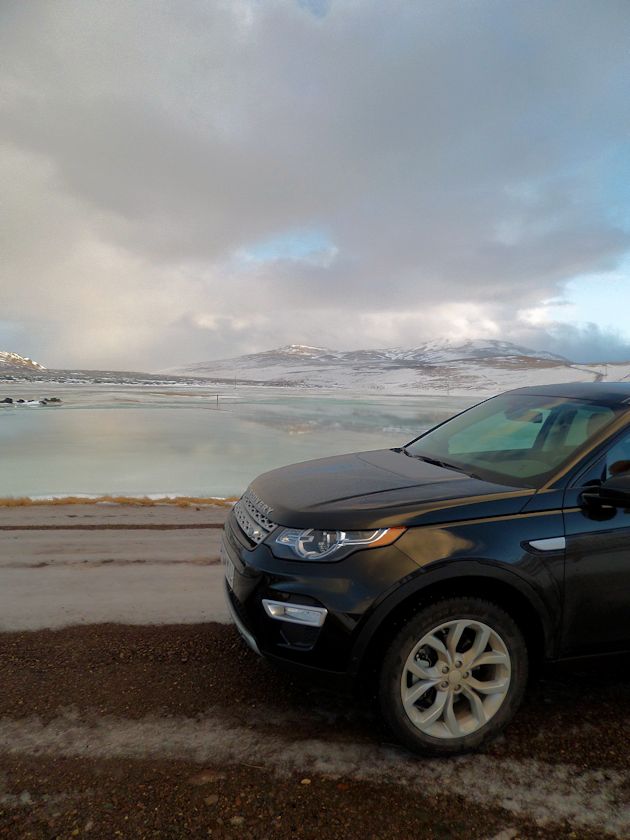Iceland ? It?s a seven and one-half hour flight from Seattle to the Keflavik International Airport in Iceland. The airport sits on peninsula that juts out into the North Atlantic Ocean just south of the capitol and largest city, Reykjavik. I was one of a group of automotive writers coming here to drive the 2015 Land Rover Discovery Sport. As I arrived just before 7 a.m. and made my way to the bus that would take us to our hotel — it was still dark.
This was my first trip to Iceland, and I expected to see barren wastelands covered in snow and ice — what I first saw was traffic jams and bumper-to-bumper vehicles. It was a Wednesday morning rush hour in the Reykjavik area and the 53 mile drive from the Keflavik International Airport to Ion Luxury Adventure Hotel to the east seemed more like a drive through Seattle or Los Angeles than a city of about only 200,000, in a country of 320,000.
 Certainly there was lots of snow and ice, but mostly I saw unfamiliar businesses and hundreds of unfamiliar small cars from familiar Asian and European brands. One of the only businesses I recognized was Ikea ? where were the McDonalds and the Taco Bells, I wondered. Two hours later when we arrived at the Ion, it was after 9 a.m. and the sun was just getting ready to peek over the mountains.
Certainly there was lots of snow and ice, but mostly I saw unfamiliar businesses and hundreds of unfamiliar small cars from familiar Asian and European brands. One of the only businesses I recognized was Ikea ? where were the McDonalds and the Taco Bells, I wondered. Two hours later when we arrived at the Ion, it was after 9 a.m. and the sun was just getting ready to peek over the mountains.
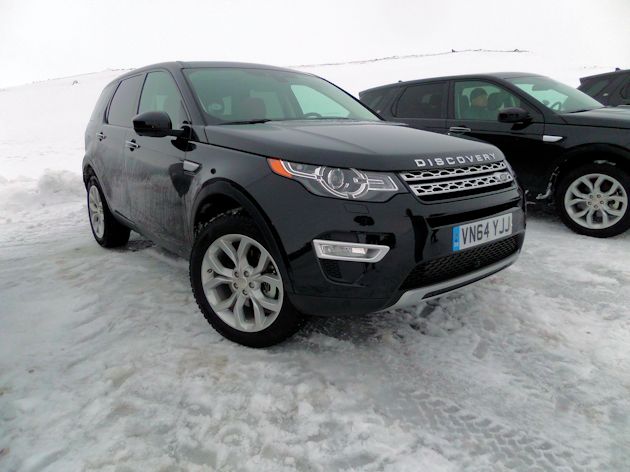 I imagine that a Land Rover is one of the most aspirational sport utility vehicles on the market — you know the kind of vehicle people would probably buy, ?If I win the lottery?. However, people making such comments are probably thinking the upscale Range Rovers and Range Rover Sport with prices that range from the $60,000s to $150,000 ? you know, the kind the Queen rides in.
I imagine that a Land Rover is one of the most aspirational sport utility vehicles on the market — you know the kind of vehicle people would probably buy, ?If I win the lottery?. However, people making such comments are probably thinking the upscale Range Rovers and Range Rover Sport with prices that range from the $60,000s to $150,000 ? you know, the kind the Queen rides in.
 Land Rover does have more affordable models, including the LR4, LR2 and Evoque, but they?ve never given me that same ?I am special feeling?? that comes from driving the Range Rover and Range Rover Sport.
Land Rover does have more affordable models, including the LR4, LR2 and Evoque, but they?ve never given me that same ?I am special feeling?? that comes from driving the Range Rover and Range Rover Sport.
 That?s all changed with the introduction of the 2015 Land Rover Discovery Sport. With pricing starting at $37,995, including the destination charge, the Discovery Sport delivers the heritage, refinement and capabilities that make a Land Rover a Land Rover ? still aspirational, but affordable. I felt as if I was driving something special?only slightly smaller.
That?s all changed with the introduction of the 2015 Land Rover Discovery Sport. With pricing starting at $37,995, including the destination charge, the Discovery Sport delivers the heritage, refinement and capabilities that make a Land Rover a Land Rover ? still aspirational, but affordable. I felt as if I was driving something special?only slightly smaller.
 The Discovery Sport starts with the same mechanical architecture used on the sporty Range Rover Evoque, except the Discovery offers a seating option for seven in three rows of seating in a 5+2 configuration with the second row elevated by two inches to allow for better forward visibility. Cargo space with the third row folded is 16.9 cubic feet which can be expanded to 67 cubic feet when the second and third row seatbacks are folded.
The Discovery Sport starts with the same mechanical architecture used on the sporty Range Rover Evoque, except the Discovery offers a seating option for seven in three rows of seating in a 5+2 configuration with the second row elevated by two inches to allow for better forward visibility. Cargo space with the third row folded is 16.9 cubic feet which can be expanded to 67 cubic feet when the second and third row seatbacks are folded.
 The styling is crisp and muscular with a distinctive new ?C? pillar design that distinguishes the Discovery Sport from the other more boxy-looking models. To maintain its trim athletic character engineers have used aluminum for the roof, hood, tailgate and suspension.
The styling is crisp and muscular with a distinctive new ?C? pillar design that distinguishes the Discovery Sport from the other more boxy-looking models. To maintain its trim athletic character engineers have used aluminum for the roof, hood, tailgate and suspension.
?Discovery Sport?s design will resonate not only with existing Land Rover consumers, but also an entirely new generation of buyers,? said Gerry McGovern, Land Rover Design Director and Chief Creative Officer. ?We?ve refused to allow functionality to compromise Land Rover?s design leadership and vice versa; both interior versatility and off-road capability are class-leading. Discovery Sport is the ultimate all-round compact premium SUV.?
 The Discovery Sport interior, while not quite at the same level as the upscale Range Rover models, is attractive, well designed and comfortable easily making it one of the best in the upscale premium compact SUV grouping. My driving partner and I found it to be very comfortable even on an intensive all-day drive, on all kinds of roads and from dry pavement to icy dirt roads to fording a fast moving river.
The Discovery Sport interior, while not quite at the same level as the upscale Range Rover models, is attractive, well designed and comfortable easily making it one of the best in the upscale premium compact SUV grouping. My driving partner and I found it to be very comfortable even on an intensive all-day drive, on all kinds of roads and from dry pavement to icy dirt roads to fording a fast moving river.
The upper trim levels of the Discovery Sport feature extra touches like twin-needle stitched leather on the instrument panel and door surfaces along with accents of real metal, not merely simulated metal. All the models do come with standard leather seating surfaces with the top levels getting more luxurious treatments.
Land Rover plans to offer an extensive list of wheel choices and various personalization options for an owner to customize the Discovery. I thought the center armrest cooler/warmer box was an interesting option.
At launch the standard drivetrain is a 240-hp 2.0-liter turbocharged four-cylinder engine with a nine-speed ZF automatic transmission and all-wheel drive. The transmission is controlled by the large dial on the center console and when manual shifting is called for it has steering wheel-mounted shift paddles. The transmission makes smooth positive shifts and I appreciate having the shift paddles, they were especially useful on the icy roads where I could downshift a few gears to slow for a corner without having to tap the brakes. The combination four-cylinder engine and nine-speed automatic transmission produces a very good SUV fuel economy level of 20 mpg city and 26 mpg highway. Land Rover says the Discovery Sport accelerates from 0 to 60 mph in 7.8 seconds and has a top speed of 124 mph. A diesel option is planned for later in this year.
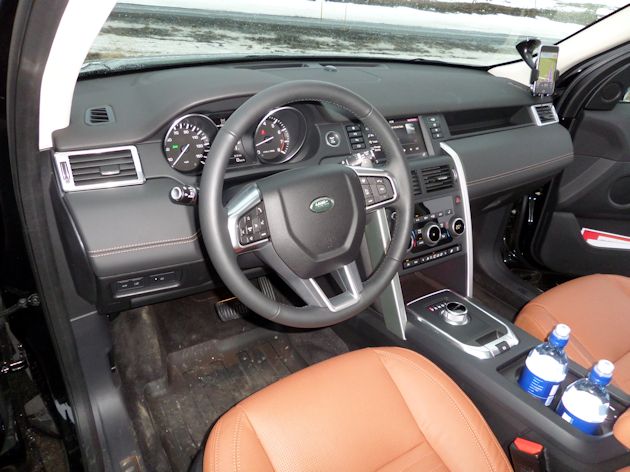 Unlike some premium compact SUVs that look good but are best suited for urban exploration, the 2015 Discovery Sport is the full-fledged Land Rover with a full range of capabilities both on and off-road. The Land Rover signature Terrain Response? system allows the driver to select from five different terrain conditions: General, Grass/Gravel/Snow; Mud and Ruts; Sand and optionally a Dynamic mode which heightens on-road performance and driver feedback.
Unlike some premium compact SUVs that look good but are best suited for urban exploration, the 2015 Discovery Sport is the full-fledged Land Rover with a full range of capabilities both on and off-road. The Land Rover signature Terrain Response? system allows the driver to select from five different terrain conditions: General, Grass/Gravel/Snow; Mud and Ruts; Sand and optionally a Dynamic mode which heightens on-road performance and driver feedback.
The list of all terrain technologies includes Hill Descent Control, Gradient Release Control?, Wade SensingTM,?Roll Stability Control; Dynamic Stability Control,?Electronic Traction Control and?Engine Drag torque Control. Each of these helps the driver to maintain optimum control over the vehicle through a broad range of driving conditions. What all this means to the Discovery Sport driver is excellent control on nearly any type of surface or terrain and in many cases it will keep the driver out of trouble.
 Most of these driver aids are familiar but the Wade Sensing? is a new one for me. The Discovery Sport is capable of going through water up to 24 inches deep and the wade sensing system informs the driver of the water depth with a visual display on the eight-inch touchscreen. This feature is especially useful at night. The vehicle?s engine air intake is mounted high above the wheel arch to insure no water enters the engine. The doors also have extra seals to keep water out of the cabin. We experienced how well this works when driving through a fast moving river at one point on our drive.
Most of these driver aids are familiar but the Wade Sensing? is a new one for me. The Discovery Sport is capable of going through water up to 24 inches deep and the wade sensing system informs the driver of the water depth with a visual display on the eight-inch touchscreen. This feature is especially useful at night. The vehicle?s engine air intake is mounted high above the wheel arch to insure no water enters the engine. The doors also have extra seals to keep water out of the cabin. We experienced how well this works when driving through a fast moving river at one point on our drive.
Iceland is a spectacular test track for an off-road vehicle and the Land Rover Discovery Sport handled all the conditions we experienced with flying colors. The test vehicles did not have the standard tires, but instead were equipped with Pirelli Scorpion studded tires which provided better traction in the icy conditions we experienced.
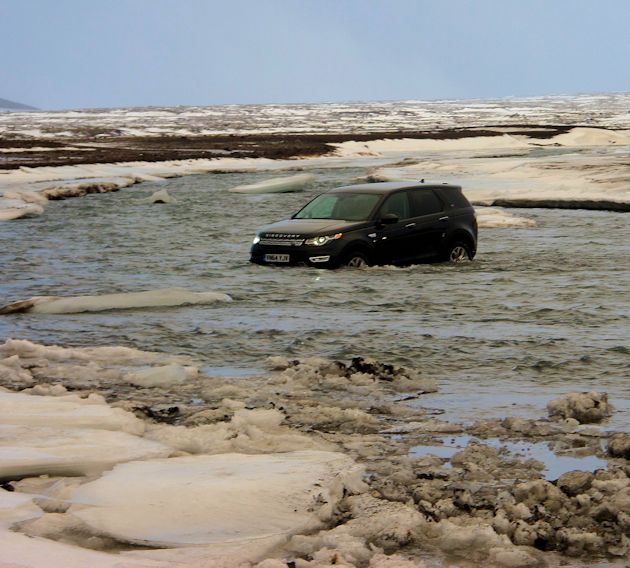 Part of the appeal of the Discovery Sport is the advanced safety technologies available including innovations like a pedestrian airbag which is mounted between the front bumper cover and bumper beam. It deploys in 60 milliseconds when it detects an impact at 15 to 30 mph to help reduce the risk of serious injury to a pedestrian. One other innovation is the Autonomous Emergency Braking which helps avoid or mitigate collisions below 50 mph.
Part of the appeal of the Discovery Sport is the advanced safety technologies available including innovations like a pedestrian airbag which is mounted between the front bumper cover and bumper beam. It deploys in 60 milliseconds when it detects an impact at 15 to 30 mph to help reduce the risk of serious injury to a pedestrian. One other innovation is the Autonomous Emergency Braking which helps avoid or mitigate collisions below 50 mph.
Combined with features like Park Assist, Automatic High-Beam Assist, Lane departure Warning, Traffic Sign Recognition, Trailer Stability Assist, Blind Spot Monitoring and Close Vehicle Sensing the Discovery Sport has nearly all the same features at the Range Rovers.
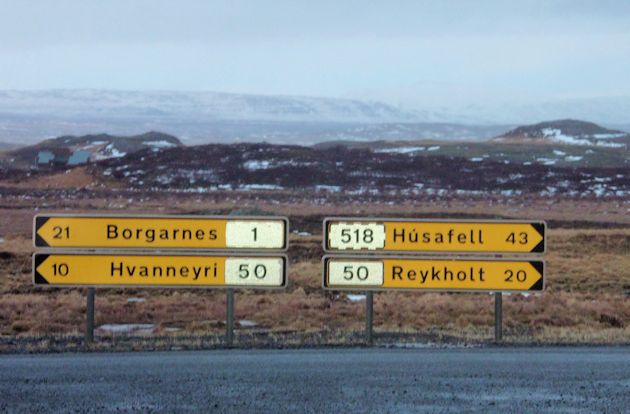 The 2015 Land Rover Discovery Sport comes in three trim levels. The SE starts at $37,995, including the destination charge. Then there are the HSE and HSE Lux at $42,495 and $46,495 respectively. With all the available options the Discovery Sport price can climb over $50,000; making it a no compromise vehicle but still at an affordable price.
The 2015 Land Rover Discovery Sport comes in three trim levels. The SE starts at $37,995, including the destination charge. Then there are the HSE and HSE Lux at $42,495 and $46,495 respectively. With all the available options the Discovery Sport price can climb over $50,000; making it a no compromise vehicle but still at an affordable price.

